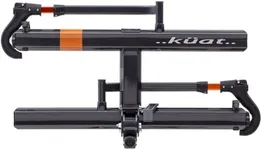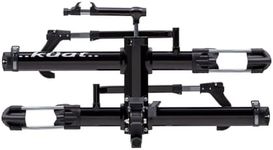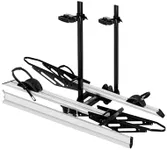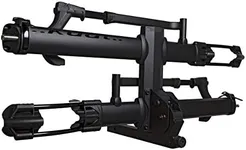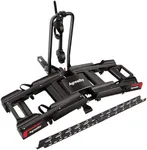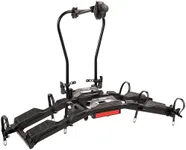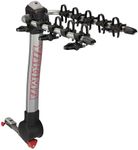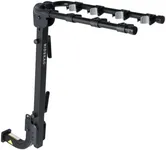Buying Guide for the Best Fat Bike Hitch Rack
Choosing the right fat bike hitch rack is essential for safely and conveniently transporting your bike. Fat bikes have unique dimensions and weights, so it's important to select a rack that can accommodate these features. Here are some key specifications to consider when making your choice, along with explanations to help you understand their importance and how to navigate them.Weight CapacityWeight capacity refers to the maximum weight the hitch rack can support. This is crucial because fat bikes are generally heavier than standard bikes. Racks typically range from 50 to 160 pounds per bike. If you have a particularly heavy fat bike, ensure the rack can handle its weight to avoid damage or accidents. Consider the combined weight if you plan to carry multiple bikes.
Tire Width CompatibilityTire width compatibility indicates the range of tire widths the rack can accommodate. Fat bikes have wider tires, usually between 3.8 to 5 inches. Ensure the rack can fit your bike's tire width to secure it properly. Some racks come with adjustable cradles or straps to fit various tire sizes, which can be useful if you have multiple bikes with different tire widths.
Hitch Receiver SizeHitch receiver size is the dimension of the hitch mount that attaches to your vehicle. Common sizes are 1.25 inches and 2 inches. It's important to match the hitch receiver size of the rack with your vehicle's hitch to ensure a secure fit. If you have a smaller vehicle, you might need an adapter, but always check the compatibility to avoid instability.
Bike Mounting SystemThe bike mounting system refers to how the bike is secured to the rack. There are different systems like frame clamps, wheel clamps, or a combination of both. Frame clamps are versatile but can cause scratches, while wheel clamps are gentler on the bike's frame. Choose a system that offers a balance between security and protection based on your bike's design and your preference for ease of use.
Ease of InstallationEase of installation is about how simple it is to attach the rack to your vehicle and load your bike onto it. Some racks come pre-assembled and require minimal setup, while others might need more effort. Consider how often you'll be using the rack and your comfort level with installation. Quick-release systems can save time and effort, especially if you frequently mount and dismount the rack.
Security FeaturesSecurity features include locks and anti-theft mechanisms that protect your bike and the rack itself. Look for racks with integrated locks for both the bike and the hitch. This is important to prevent theft when you leave your bike unattended. Some racks offer additional security features like locking cables or bolts, which can provide extra peace of mind.
Rack Material and DurabilityRack material and durability refer to the construction quality of the rack. Common materials include steel and aluminum. Steel racks are generally more durable and can handle heavier loads, but they are also heavier. Aluminum racks are lighter and resistant to rust, making them easier to handle and maintain. Choose a material based on your need for durability versus ease of handling.
Foldability and StorageFoldability and storage pertain to the rack's ability to fold down when not in use. This feature is important for convenience and space-saving, especially if you have limited storage space. Some racks can fold flat against the vehicle or be easily removed and stored. Consider how often you'll need to store the rack and the available space you have for it.
